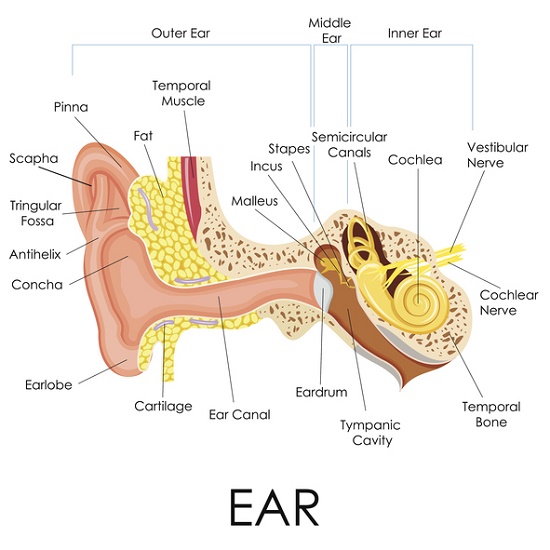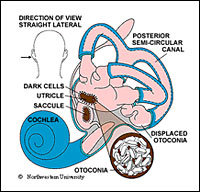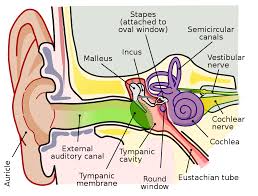6 Poorly Understood Conditions That Lead to Hearing Loss and Balance Problems
by Geneva Hearing Services | Mar 16, 2017 | Hearing Loss Articles

Hearing loss is a growing problem in the United States, one that involves 48 million people nationwide, or, around 20 percent of the entire population. The chances you know someone who has hearing loss are around 1 in 5.
For most individuals, hearing loss results from excessive exposure to loud noises or is a consequence of aging. For some individuals, though, It is a sign of a less common condition.
Consider six poorly understood hearing and balance disorders you should know more about.
Benign Paroxysmal Positional Vertigo (BPPV)
BPPV involves vertigo related to a collection of calcium carbonates crystals, or “ear rocks,” that form inside the inner ear. The medical name for these crystals is otoconia.
The ear rocks typically occur due to a head injury, an infection, or similar disorders. Symptoms of BVVP include dizziness, poor balance, lightheadedness, and nausea. They may worsen with changes in head position.
Benign paroxysmal positional vertigo can heal without therapy, but there are treatment options available including head exercises designed to move the crystals out of the inner ear structures. Drug therapy is also sometimes used and, occasionally, surgery.
Labyrinthitis
Labyrinthitis is a disease that involves inflammation and/or irritation that affects the inner ear and hearing nerves – usually related to a viral, or less commonly, a bacterial, infection. This swelling interrupts the transmission of sensory information to the brain, causing difficulties with balance, hearing, and even vision.
The treatments generally offered include antiviral or antibacterial drugs and therapies used to control the symptoms of dizziness or nausea. If quickly diagnosed and treated, labyrinthitis usually causes no permanent damage. However, if left alone, permanent hearing loss can result.
Ménière’s disease
Ménière’s disease is an inner ear problem that leads to vertigo, progressive hearing loss, ringing in the ears, and a feeling of fullness or pressure in the ear.
The cause of Ménière’s disease is not fully known but it might be a combination of several factors, including poor fluid drainage of the inner ear, unusual immune response, viral infection, genetic predisposition, and head injury.
Treatment options include medications for vertigo, hearing aids for hearing loss and tinnitus relief, antibiotics to treat infections, and surgery for severe cases.
Acoustic neuroma
An acoustic neuroma is a benign tumor of the hearing and balance nerves that disrupts the transmission of hearing and balance data to the brain. Although this tumor does not spread to other organs, it can become large enough to cause hearing loss and balance problems.
There are over 5,000 cases of acoustic neuroma annually in the US. Treatment generally includes surgical removal of the tumor or radiation. Without treatment, the acoustic neuroma may eventually push into the brain, threatening neurological function and even life.
Autoimmune inner ear disease (AIED)
Autoimmune inner ear disease is an uncommon but progressive condition directly related to the immune cells attacking the mechanisms of the inner ear. Like most autoimmune disorders, the cause is not well understood.
Symptoms can include hearing loss, balance problems, and tinnitus. Diagnosis includes hearing tests and also blood tests to check for general autoimmune disease.
Treatment opportunities are limited but growing, currently; they include some combination of steroids, other medications, plasmapheresis, and hearing aids or cochlear implants for hearing loss.
Otosclerosis
Otosclerosis is a problem that involves the hardening of bones in the inner ear bones. These bones are critical elements in the transmission of sound vibrations to the inner ear and then to the brain. The hardening of these bones interferes will eventually lead to slowly progressing hearing loss.
Otosclerosis is usually genetic, so it runs in families. If one parent has the disorder, there is a 25 percent chance of the child developing it, as well; two parents have the condition that likelihood increases to 50 percent.
Treatment options for mild forms of the disease include long-term observation or hearing aids. Sodium fluoride is sometimes offered to slow the progression of the disorder. In certain situations, a surgical procedure called stapedectomy is done to remove the hardened bones and replaced them with a prosthetic device.

Allison Aubrey wrote about the Treatment.
She is a correspondent for NPR News, where her stories can be heard on Morning Edition and All Things Considered.
She’s also a contributor to the PBS NewsHour and is one of the hosts of NPR’s Life Kit.
The Treatment
The main strategy used to move the rocks out of the canal is called the Epley maneuver. It was first introduced in the late 1980s, and has since been adopted by many ear specialists, neurologists, physical therapists and audiologists.
At the Washington Hospital Center, in Washington, D.C., audiologist Saul Strieb demonstrated the process. It begins with the patient moving quickly from an upright, seated position to lying flat on his or her back. The patient holds the supine position, and then turns the head. This position is held for about one minute, then the patient rolls onto his or her side. The sequence is often repeated.
“It’s not successful all the time,” says Strieb. “Sometimes it takes repeat visits.”
Several randomized clinical trials have demonstrated that the Epley maneuver is a safe and effective treatment. Some studies document an 80 percent success rate. However, there is no solid evidence that the maneuver provides a long-term resolution of symptoms. Recurrence rates may approach 50 percent, depending on the age of the patient.
For those who seek no treatment at all, the condition usually improves on its own within a few months.
In severe cases, where the symptoms linger, physicians can perform a surgery to plug the ear canal.
Written by Johns Hopkins Medicine

What is the home Epley maneuver?
The home Epley maneuver is a type of exercise help that helps to treat the symptoms of benign paroxysmal positional vertigo (BPPV). You can do this exercise at home.
BPPV is caused by a problem in your inner ear. Your semicircular canals are found inside your ear. They detect motion and send this information to your brain. The utricle is a nearby part of the ear. It contains calcium crystals (canaliths) that help it detect movement.
Sometimes these crystals detach from the utricle and end up inside the semicircular canals. When these crystals move inside the canals, they may send incorrect signals to your brain about your position. This can make you feel like the world is spinning. This is called vertigo.
Dr. John Epley designed a series of movements to dislodge the crystals from the semicircular canals. These movements bring the crystals back to the utricle, where they belong. This treats the symptoms of vertigo.
The original Epley maneuver was designed to be done with a healthcare provider. The home Epley maneuver is similar. These are a series of movements that you can do without help, in your own home.
Why might I need the home Epley maneuver?
You may need to try the home Epley maneuver if you have symptoms of BPPV. In BPPV, vertigo may come on with certain head movements. It may last for up to a minute. These symptoms may be more frequent at times. You may also have nausea and vomiting.
Often BPPV happens without any known cause. Sometimes there is a cause. Causes of BPPV can include:
- A head injury
- Problems after ear surgery
The home Epley maneuver is safe and inexpensive. It often works well to treat the symptoms of BPPV.
Your healthcare provider may suggest the home Epley maneuver if your health history and physical exam support that you have BBPV. Your healthcare provider may also suggest that you see a vestibular therapist for treatment.
Your healthcare provider may first do the original Epley maneuver in his or her office. He or she may teach you the home Epley maneuver. You may need to do the home Epley maneuver if you still have symptoms after you leave your healthcare provider’s office. It may also be useful to know how to do this maneuver if your BPPV comes back after a few months or years.
What are the risks of home Epley maneuver?
The home Epley maneuver is safe. It may be helpful to have someone at home with you while you go through the movements. This can give you peace of mind in case your vertigo gets worse in the middle of the treatment.
People with health conditions that limit their ability to move may not be able to do the home Epley maneuver safely. These issues can include neck or back disease, vascular conditions, and retinal detachment. Ask your healthcare provider if the home Epley maneuver is safe for you.
How do I get ready for the home Epley maneuver?
You can do the home Epley maneuver on a bed. You start by sitting on the bed. You need to have a pillow in place so that when you lie back it will be under your shoulders.
What happens during the home Epley maneuver?
You may find it helpful to watch a video of the home Epley maneuver first. Or read a brochure with pictures.
Your healthcare provider will tell how often to do this procedure. He or she may ask you to do it 3 times a day until your symptoms have been gone for 24 hours. Your healthcare provider will also tell if your right or left ear is causing your symptoms.
Follow these steps if the problem is with your right ear:
- Start by sitting on a bed.
- Turn your head 45 degrees to the right.
- Quickly lie back, keeping your head turned. Your shoulders should now be on the pillow, and your head should be reclined. Wait 30 seconds.
- Turn your head 90 degrees to the left, without raising it. Your head will now be looking 45 degrees to the left. Wait another 30 seconds.
- Turn your head and body another 90 degrees to the left, into the bed. Wait another 30 seconds.
- Sit up on the left side.
Follow these steps if the problem is with your left ear:
- Start by sitting on a bed.
- Turn your head 45 degrees to the left.
- Quickly lie back, keeping your head turned. Your shoulders should now be on the pillow, and your head should be reclined. Wait 30 seconds.
- Turn your head 90 degrees to the right, without raising it. Your head will now be looking 45 degrees to the right. Wait another 30 seconds.
- Turn your head and body another 90 degrees to the right, into the bed. Wait another 30 seconds.
- Sit up on the right side.
What happens after the home Epley maneuver?
Most people say their symptoms go away right after they do the maneuver. In some cases, it may take a few times for the procedure to work. Some people may have mild symptoms for a couple of weeks. Once your symptoms go away, there is no need to keep doing the maneuver.
Your healthcare provider may suggest avoiding certain positions for a while after your symptoms have gone away. For instance, you may need to sleep propped up on 2 pillows, to keep your neck from extending straight.
If you still have symptoms after doing the home Epley maneuver, call your healthcare provider. You may not be doing the maneuver the right way. Or you may have another problem that’s causing your symptoms of vertigo. The home Epley maneuver only works to treat vertigo from BPPV. But many other conditions can cause vertigo.
You should be able to be active after doing the home Epley maneuver. Make sure your vertigo has really gone away before doing anything dangerous, such as driving.
With the help of the home Epley maneuver, your vertigo may go away for weeks or even years. BPPV often comes back, though. This might happen if another calcium crystal ends up in your semicircular canals. If your vertigo comes back, do home Epley maneuver again to see if your symptoms go away. If the maneuver doesn’t work, call your healthcare provider.
Next steps
Before you agree to the test or the procedure make sure you know:
- The name of the test or procedure
- The reason you are having the test or procedure
- What results to expect and what they mean
- The risks and benefits of the test or procedure
- What the possible side effects or complications are
- When and where you are to have the test or procedure
- Who will do the test or procedure and what that person’s qualifications are
- What would happen if you did not have the test or procedure
- Any alternative tests or procedures to think about
- When and how will you get the results
Who to call after the test or procedure if you have questions or problems - How much will you have to pay for the test or procedure
Below are eight asanas (yoga poses) that help improve circulation and Improve your Healing!
- Trikonasana (triangle pose)
- Padangusthasana (hand to big toe pose)
- Adho Mukha Svanasana (downward facing dog)
- Ustrasana (camel pose)
- Gomukhasana (cow face pose)
- Bhujangasana (cobra pose)
- Viparita Karani (legs up the wall)
Can Nutrition help?
Nutrition for Your Ears for all
- Magnesium. Magnesium along with Vitamins A, C & E plays an essential role in hearing health.
- Omega-3 Fatty Acids. Researchers claim that Omega 3 fats strengthen the blood vessels in our ear’s sensory system. …
- Potassium. …
- Folate or Folic Acid.
You are unique and most people need an assessment to see if nutrition can help you hear better!

